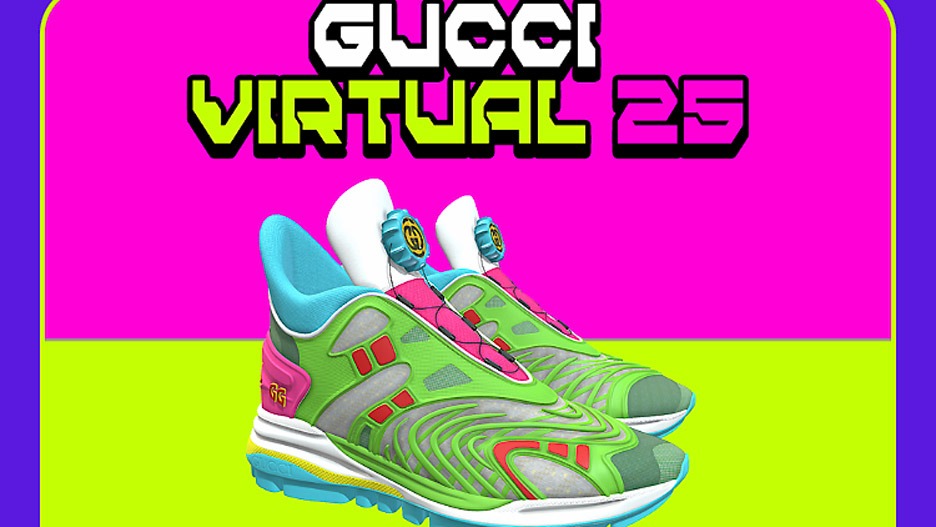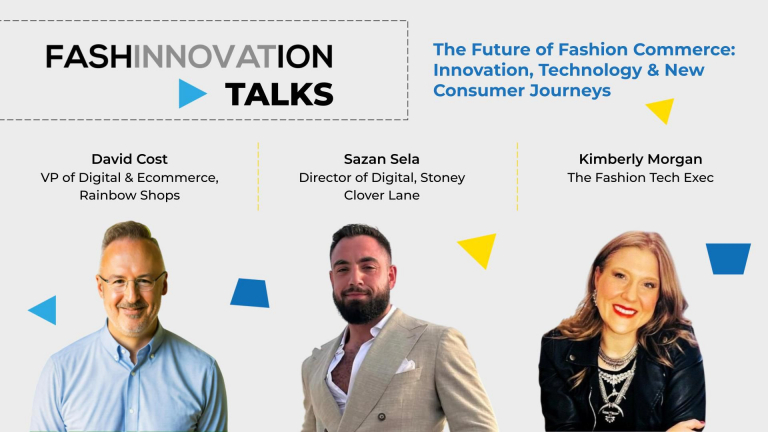Would you ever spend money on a pair of sneakers that do not physically exist? From young brands to luxury houses like Gucci, the digital product space is growing. Coming alive via blockchain and augmented reality technologies, digital fashion is a new way of thinking that is set to decentralize the fashion industry in a world where the online persona is an extension of the real self.

GUCCI’S LUXURY SNEAKERS FOR A COUPLE OF BUCKS
Gucci’s Creative Director Alessandro Michele has designed neon-colored sneakers in collaboration with the Belarus-based augmented reality fashion platform Wanna. The Virtual 25, which can be purchased between $9 and $12 on either company’s mobile apps, is designed only to be worn in digital spaces.
In the past, the brand had offered their existing designs in digital forms for video games, such as Drest, Sims 4, Pokemon, and the 3-D social media app Zepeto. While the buyers of The Virtual 25 can access a downloadable version of the sneakers to be worn by their avatars in online games and VR platforms such as Roblox, they can also “wear” their digital sneakers in social media posts.
FROM THE GAMING WORLD TO COUTURE: A BRIEF HISTORY OF DIGITAL FASHION
Digital fashion products are not a new concept for the internet. Known as “skins” in the gaming world, it has been a part of games such as Fortnite and League of Legends. Yet, the gaming skins are just proof of the potential that the digital fashion market holds. The digital-only product space is expanding from the gaming world to social media with the large sales of digital creative assets in non-fungible token form (NFT), rise in online gaming, and the pandemic-driven e-commerce boom.

In 2018, the Scandinavian retailer Carlings released the first digital-only clothing collection to raise awareness on waste created by un-used clothes. When the customers bought a digital piece of clothing, they were asked to upload photos of themselves and were dressed up by artists at Vice. The buyers could then post pictures of themselves on social media “wearing” their newest items. DressX, which is the first digital international clothing retailer, also employs a similar process.
In 2019, the industry had its first digital-only couture dress on blockchain sold for $9,500. Digital fashion house The Fabricant’s dress Iridescence is a landmark moment in digital fashion as it was a first-of-its-kind blockchain transaction. The garment was traceable, tradeable, and collectible.
While the digital fashion market is still only at the tip of the iceberg, many brands are taking advantage of augmented reality to create 3D models for digital fittings. Brands and retailers like Rebok, Farfetch, and Puma offer virtual try-on and customers to take photos of themselves with new products. In addition, many brands realize the potential of NFTs as the next evolution of digital fashion. Gucci recently confirmed to Vogue Business that they will release an NFT along with other luxury fashion houses.
CAN DIGITAL FASHION SOLVE THE INDUSTRY’S PROBLEMS?
While the digital fashion market is yet a promise rather than a fully realized reality, the avenue holds substantial potential, more than its ability to earn easy likes. By pushing the fashion industry’s boundaries, digital fashion is tied to sustainability, creative expression, and new business opportunities.
ENVIRONMENTAL AND SOCIAL SUSTAINABILITY
Producing a digital-only product means that a physical factory is not needed; transportation and packaging costs are non-existent. As the production costs and time to market are reduced, so is the use of traditionally polluting practices in the fashion industry.
The fashion industry is one of the major polluting industries globally, responsible for 10% of total carbon emissions. A digital garment production emits 97% less carbon dioxide than that of a physical garment, offering a way to eliminate waste, chemicals, and excessive water use. Carlings’ most recent The Last Statement T-Shirt continues to target the fashion industry’s waste problem by re-inventing youth rebellion for the digital age. Customers can buy one t-shirt yet transform it into hundreds of designs with custom Instagram/Facebook filters.
In addition to environmental sustainability, digital fashion also offers a way to have an impact socially. With blockchain technology, brands can trace supply chains and verify authenticity sourcing practices even when producing physically. With this technology, brands can keep an eye on all procedures, including ethical sourcing.
BUSINESS OPPORTUNITIES: ATTRACTING AUDIENCE
Digital fashion’s sustainability promise is also an avenue to drive revenues. Affordable digital fashion products, such as Gucci’s $12 The Virtual 25, can especially attract the Gen-Z audience, an environmentally and socially conscious generation with a spending power above $140 billion.
CREATIVE EXPRESSION: BREAKING FREE OF PHYSICAL LIMITATIONS
Digital fashion can go beyond traditional fashion design boundaries as designers can explore endless possibilities with digital-only products that do not exist in real life. With Iridescence, The Fabricant explored what identity could mean when there were endless bits and bytes to self-expression as a body got freed from physical restraints. In addition, digital fashion can offer a new definition of size, body, and gender inclusivity as bits and bytes can come together to create truly universal, genderless, and sizeless garments.
Want to learn more about digital fashion? Check out our previous article “Fashion in Video Games”.
* By Elif Kesikbas






